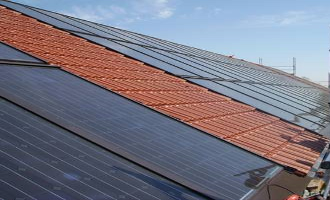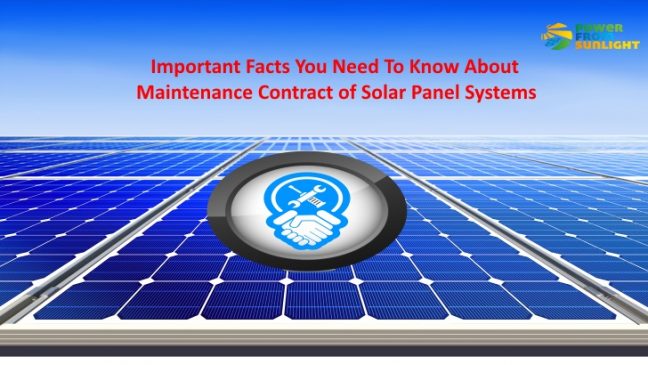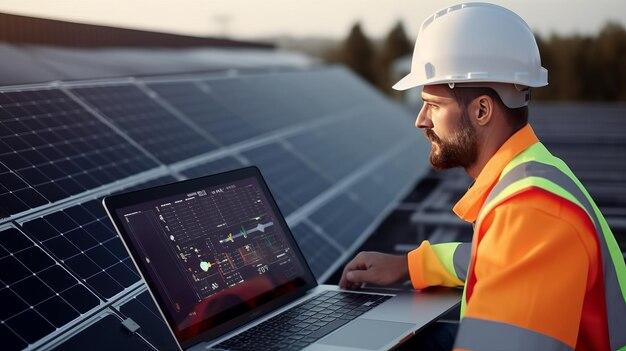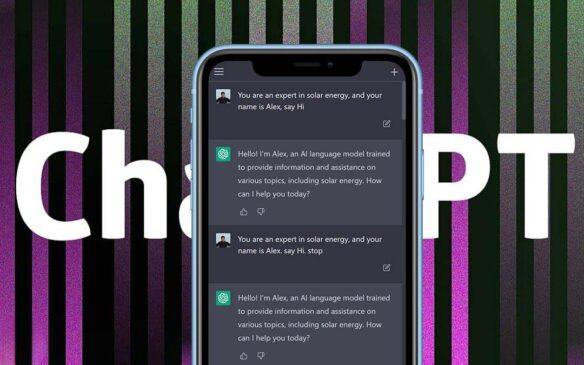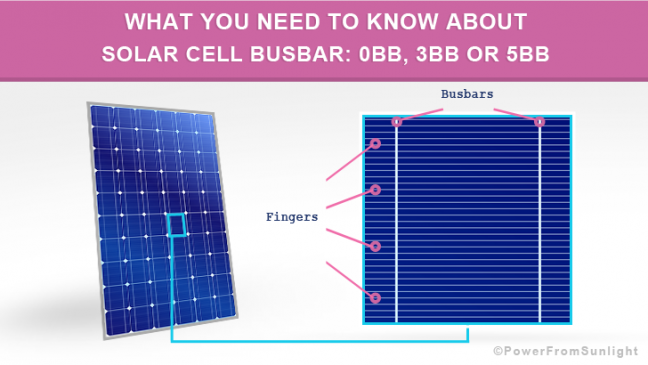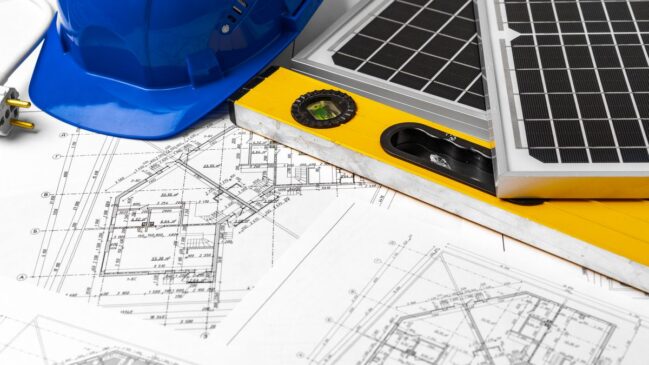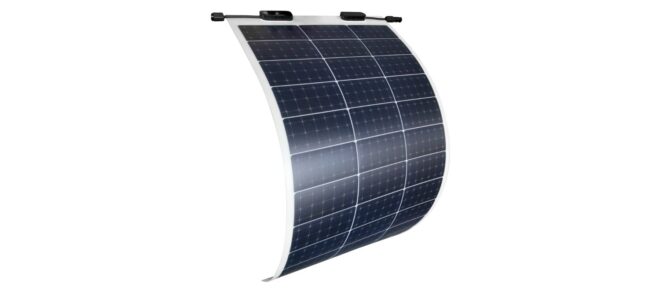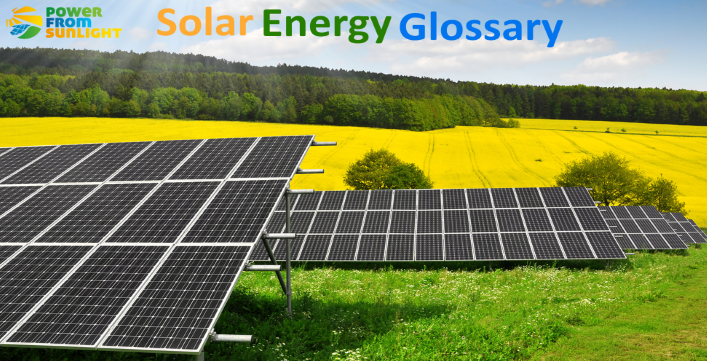
A B C D E F G H I L M N O P R S T U W Z
This Solar Energy Glossary contains simple definitions for technical terms related to photovoltaic (PV) and different types of solar Energy technologies, including terms having to do with electricity and renewables energies.
A
Air source heat pump is a system which exchanges hot or cold air from one place to another, i.e. from inside a building to the outside and vice versa, and creates the desired room temperature using either cooling or heating the area.
Air-water heat pump describes a heat pump whereby heat is extracted from the ambient external air and transferred to water, which in turn, is used for heating either a space or domestic hot water for sanitation purposes.
This type of system uses a mixture of a direct acting outdoor unit coupled with an indirect indoor section.
Alternating current (AC): An electric current which reverses its direction at regularly recurring intervals.
Alternative energy: Energy which results from a natural source which is not depleted through use (sun, water, wind, geothermal heat, and biomass energy).
Amorphous silicon: A thin-film silicon photovoltaic cell with no crystalline structure. Manufactured by depositing layers of doped silicon on a substrate.
Anti-islanding: The process that prevents circuits from remaining powered after all power is cut off from the grid source.
B
Ballasted Mount: A racking system that supports solar panels which are placed on a flat roof. This racking system is held in place by concrete blocks installed inside the rack.
Battery backup systems can store electricity from the grid or a fuel-powered generator to provide emergency power when the grid goes down.
It can also store energy created by a PV system to power appliances and lights at night after the sun goes down.
Battery Capacity: The maximum total electrical charge, expressed in ampere-hours, which a battery can deliver to a load under a specific set of conditions.
Battery inverter: An inverter designed for use with batteries.This is required for home energy storage if the solar inverter is not a hybrid solar inverter that is compatible with the batteries used.
Battery life is a measure of battery performance and longevity, which can be quantified in several ways: as run time on a full charge, as estimated by a manufacturer in milliampere hours, or as the number of charge cycles until the end of useful life.
Bioenergy: Energy generated from biomass.
Biofuel: A fuel produced from biomass.
Biomass: A renewable energy resource derived from organic material.
Biomass includes wood, agricultural waste, and other living-cell material that can be either burned directly to produce energy or converted into liquids or gaseous fuel.
Blackout: A total loss of electrical power.
Building-integrated photovoltaics (BIPV) where the solar panels become an integral part of the building. These modules can be integrated into building facades, roofs, awnings, and similar applications.
C
Cable Losses (<1%): All cables produce losses when electricity is passed through them. The larger the cable, the lower the loss. When designing a system, the guidelines state to keep the overall cable losses to below 1%.
In some cases, this is not possible as the place where the panels/inverter is placed is a long distance to the meterbox.
Canopy construction: Any overhanging or projecting roof structure, typically over entrances or doors. Sometimes the extreme end is unsupported.
CEC Efficiency of the inverter: For climates of higher insolations like US southwest regions, the California Energy Commission (CEC) has proposed a weighting, which is now specified for some inverters used in the US.
Central inverter: Central inverters are particularly suitable for building up photovoltaic systems with a homogeneous structure (modules of the same type with an identical alignment and inclination).
They are used for installations from 100 kW upwards, and in most cases are designed for outdoor installation.
Charge controller instand-alone systems the charge controller regulates the flow of current to and from the solar battery to protect it from overcharge and over-discharge.
Circuit breaker: A device that shuts down power when sensing an overload of current.
Cold Roof: Is a roof incorporating “above sheathing ventilation” in order to help prevent hot spots on the roof and subsequent wintertime ice dams.
Combined heat and power (CHP) / cogeneration: Generating technology in which both electric and thermal energy are obtained from a single energy source, which makes CHP generating units significantly more efficient.
Concentrated Solar Power (CSP) (or solar thermal electric energy) technologies use mirrors to focus the sunlight energy and convert it into heat to create steam to drive a turbine that generates electricity.
Conversion efficiency (module): The ratio of the electric energy produced by a photovoltaic module to the energy from sunlight incident upon the module.
Counter-battens: Vertical wood or metal strips installed on steep-slope roofs over which horizontal battens are secured. The primary roof covering is attached or secured to these horizontal battens.
Current (A): The ‘volume’ of electricity flowing in a circuit and expressed as Amps.
Cut off voltage: As a battery becomes discharged, the voltage of the current it supplies decreases.
The cutoff voltage is either the voltage at the point where the battery is fully discharged or when a charge controller stops the discharge at a pre-set point.
Most home energy storage systems have cut off voltages which prevent their batteries from being fully discharged to prolong their lives.
D
Data logger: Data storage device that logs the operating data of the inverters and enables operational monitoring of the solar installation over a longer period.
Data logging: There are various data communication systems for monitoring photovoltaic installations.
In most cases, these are installed additionally and record the amount of electricity generated, thus providing information about the proper operation of the installation.
Datasheet: These provide technical information on solar panels, inverters, and other items as well.
Deep discharge: State in which a battery is fully discharged using low current so that the voltage falls below the final discharging voltage. Discharging to below this voltage can impair or destroy the battery.
Degradation, Ageing: Solar cells age as, over the course of their lifetime, their efficiency diminishes.
This natural process of aging induced by light irradiation is called degradation. In calculating yield assumptions, this effect is already included.
Diffuse sunlight: Sunlight diffused by clouds and other atmospheric particles that have no defined direction from the sun to the observation point on the ground.
Direct current (DC): A type of electricity transmission and distribution by which electricity flows in one direction through the conductor, usually relatively low voltage and high current.
To be used for typical 120 volt or 220-volt household appliances, DC must be converted to alternating current.
Direct sunlight: Sun’s rays that fall directly from the sun to the observation point on the ground.
Distributed Generation (or Customer-Owned Generation): The generation of electricity from a number of small power plants installed at the site where they will be used as an alternative to concentrating power generation in large, centralized facilities located in remote areas.
This places less stress on transmission lines and reduces the chance of widespread blackouts. Customer-Owned Generation typically uses renewable energy sources, including small hydro, biomass, biogas, solar power, wind power, and geothermal power.
Doping: The process of introducing impurities into an extremely pure semiconductor for the purpose of modulating its electrical properties.
E
Elevated modules: Solar modules installed on flat roofs are typically elevated: they are mounted on metal posts and/or cement pillars at an angle of roughly 30 degrees.
European Efficiency of the inverter: is an averaged operating efficiency over a yearly power distribution corresponding to middle-Europe climate.
This was proposed by the Joint Research Center (JRC/Ispra), based on the Ispra climate (Italy), and is now referenced on almost any inverter datasheet.
F
Feed-in Management: Power grids distribute energy from a central source to the individual consumers. The increasing amount of PV power installed has changed this requirement. Ancillary services are already required in some countries to improve the stability of the grid.
These services require the grid operators to be able to control the output and regulate the amount of reactive power from the PV plant.
Fill factor is the ratio of a solar cell’s actual power to its power if both current and voltage were at their maxima. The fill factor is a quality criterion of solar cells.
Flexible Thin Film (Cells or modules) are created by depositing the photoactive layer and other necessary layers on a flexible background material.
Fossil fuel source: An energy source formed in the Earth’s crust from decomposed organic material. Because of its limited nature, it is not a permanent resource. The primary fossil fuels are petroleum, coal and natural gas.
Frame: External part of the modules that provide protection of the module and is useful for their fixing.
Fuse: A safety device in which a strip of wire breaks and cuts off the transmission of current if the current passing through it exceeds a certain level.
G
Galvanic isolation is a design technique that separates electrical circuits to eliminate stray currents. Signals can pass between galvanically isolated circuits, but stray currents, such as differences in ground potential or currents induced by AC power, are blocked.
Generator: A device that converts Kinetic energy generated from combustion or other method into electrical energy to provide an AC or DC power source to a load.
Generator connection box: The Generator connection box contains the safety equipment like DC circuit breaker and overvoltage protection. In the generator terminal box, all cables from the modules are connected and fixed with terminals.
Geothermal heat: The interior heat of the earth.
Geothermal Heat Pumps: Devices that use the Earth’s interior as a heat source and heat sink for both heating and cooling.
When cooling, heat is extracted from the space and dissipated into the Earth; when heating, heat is extracted from the Earth and pumped into the space.
Geothermal Power Plant: A plant in which heat energy is converted to electric power. The turbine is driven either by steam produced from hot water or by natural steam that derives its energy from heat found in rock. The steam turbine drives an electrical generator.
Global radiation refers to the total solar radiation that strikes a surface. It measures the radiation per square meter on horizontal surfaces. Global radiation includes both the direct and diffuse radiation.
Greenhouse Gases: Gases, such as methane, carbon dioxide, nitrous oxide and water vapor, that are transparent to solar (short-wave) radiation but opaque to long-wave (infrared) radiation, thus preventing longwave radiant energy from leaving Earth’s atmosphere.
The net effect is a trapping of absorbed radiation and a tendency to warm the planet’s surface.
Green Roof: A roof system designed to support the installation and growth of plants. Green roofs are an attractive and energy-saving alternative to conventional roof construction.
In addition to their environmental and aesthetic advantages, green roofs help insulate buildings, benefit the energy systems of buildings, and can extend the life of a roof.
Grid-connected PV system: A photovoltaic system which feeds its excess electrical current generated into the public power grid for later use is grid connected.
Grid-tie inverters: Devices used to change DC Power into AC Power. AC Power is electricity we use in our houses.
Grid tie inverters are different from conventional inverters because they are designed to ‘feed-into’ the existing electric supply.
H
Heat exchanger: A heat exchanger is a device for the transfer of heat energy from one medium to another.
It can take a variety of different forms; the commonest in everyday use is a central heating radiator where hot water is circulated through pipes or plates and gives its heat up to the surrounding air.
Heat Pipe: The hollow metal pipes filled with a liquid coolant that moves heat by evaporating and condensing in an endless cycle.
Heat transfer fluid: Gas or liquid whose purpose is to transfer heat from point A (the collection point) to point B (the point of use). It is used in all processes involving heat exchangers, particularly in the energy field.
In a solar collector, a heat transfer fluid heats up in the collector under the effect of the sun and then flows through a heat exchange to warm a separate tank of water providing hot water for domestic use or for heating a building.
Hot water storage tank: Is a water tank used for storing hot water for space heating or domestic use.
Hybrid Systems: These are systems that combine two or more renewable energy technologies.
A combination photovoltaic and wind system, or a photovoltaic system that recovers and utilizes heat from the panels for space or water heating are hybrid system examples.
I
IEC 61215 / EN 61215 IEC 61215 Ed. 2 Aging of PV modules
The IEC61215 covers the parameters which are responsible for the aging of PV modules. This includes all forces of nature:
- Sunlight, including UV.
- Climate (changing of climate, coldness, warmth, humidity).
- Mechanical load (hail, wind suction, wind pressure, snow parameters which are responsible for the aging of PV modules).
For the standard IEC 61215 certification, 2400 Pa uniform load applies. However:
When installing solar panels in areas with heavy snow, an increased load capacity of 5400Pa is advisable. Nowadays, many solar manufacturers produce equipment with this requirement.
IEC61646 Thin-Film PV Modules
The IEC 61646 certification is for Thin-Film PV modules and is in many aspects identical to the international standard IEC 61215 for crystalline modules.
An additional test takes the degradation behavior of amorphous silicon due to temperature and irradiance exposure into account.
IEC 61730 / EN 61730 Safety qualifications
Photovoltaic (PV) module safety qualification, which was later issued as the European standard EN 61730 (almost similar). The IEC / EN 61730 consists of 2 parts:
(1) The first part covers all the requirements for construction and states the mandatory design characteristics of the modules.
(2) The second part consists of the requirements for testing. Part 2 of the IEC / EN 61730 defines three different Application Classes for a module design, specifying the type of use, the related qualification tests, and the resulting safety class modifications.
In-roof mounting: The solar system is integrated into the roof as part of the building shell.
Inverted Roof is a form of warm roof where the principal thermal insulation is placed above the waterproof covering. This system is also referred to as a protected membrane or upside-down roof.
Inverter/Charger: This is an Inverter, designed to be used in a Battery-Based System, that has A Built-In Battery Charger and Automatic Transfer Switch.
Inverter Sizing: establishes the sizes and ratings of the inverter to meet a certain performance objective.
Inverter with transformer: This feature has something called electrical isolation. It is a safety barrier between the solar electric circuit and the utility grid connection.
IP65: The IP stands for International Protection rating.
The 6 stands for the unit being completely dust tight.
The 5 stands for the water jets sprayed from any direction not having any harmful effects.
The rating can be applied to any enclosure or piece of electronic equipment. When specifically applied to inverters the unit can be mounted outside with no detrimental effects.
L
Light-Induced Degradation: (LID) is a phenomenon that occurs in solar panels. All solar cells degrade when they are first exposed to sunlight.
Load: Any device that consumes electricity in order to operate. Appliances, tools, and lights are examples of electrical loads.
M
Maximum efficiency or Peak efficiency: This measures the efficiency of the inverter at one point–when it is performing at its best. So simply put, peak efficiency is calculated as DC input to AC output when the inverter is operating at (usually) its rated capacity.
Maximum input current (Idcmax): Maximum current at which the inverter can operate. If the inverter has multiple MPP inputs, Idcmax is related to each single input.
Maximum input voltage (Vdcmax): The allowed maximum voltage at the inverter input.
Maximum MPP voltage (Vmppmax): Maximum voltage at which the inverter can deliver its rated power.
Maximum Power Current or Maximum Power Point Current (Ipm): The current at which maximum power is produced by a solar panel.
Maximum Power Point (MPP): The point on the current-voltage (I-V) curve of a module under illumination, where the product of current and voltage is maximum.
Maximum power point tracker (MPPT): Means of a power conditioning unit that automatically operates the photovoltaic generator at its maximum power point under all conditions.
Maximum Power Voltage or Maximum Power Point Voltage (Vpm): The voltage at which a solar panel produces maximum power.
Maximum series fuse rating: The current reading at which the fuse will open and cause the circuit to break to protect the solar panel from damaging.
Maximum System Voltage (VDC): The maximum voltage that can be generated by linking more solar panels in a series to form a solar array.
Micro inverter: A device that converts direct current (DC) from a single panel to alternating current (AC). When used, each panel will have an individual microinverter.
Minimum input voltage (Vdcmin): Minimum input voltage for the inverter to energize the utility grid, independent of its mode of operation.
Minimum MPP voltage (Vmppmin): Minimum voltage at which the inverter can deliver its rated power.
Mismatch losses are caused by the interconnection of solar cells or modules which do not have identical properties or which experience different conditions from one another.
Mounting rails enable the solar panels to be attached to the roof and subsequently support them in place.
Multi-String inverter: An inverter which, to a large extent, combines the advantages of several string inverters (separate MPP control of individual strings) and a central inverter (low output-related costs).
N
Net Meter: This is the piece of equipment the utility installs for you in conjunction with your solar installation.
Unlike traditional utility meters, a net meter counts up and down. It displays the “net usage” – the difference between how much solar electricity you generated at your property, and how much electricity you took from the utility grid.
Noise emission or Sound emission is the noise that occurs at a sound source. Sound emission is caused by mechanical vibrations (e.g. rotating machine tools, saws) or by flow processes in equipment (e.g. compressed air) and is emitted by these sound sources.
Nominal Operating Cell Temperature (NOCT) is defined as the temperature reached by open circuited cells in a module under the conditions as listed below: Irradiance on cell surface = 800 W/m2, Air Temperature = 20°C and Wind speed = 1 m/s.
NOCT is used to estimate the nominal operating temperature of a module in its working environment.
O
Off-grid PV system (Stand-alone PV system): A Solar system that is not connected to the utility grid and is used particularly in remote regions where connection to the public power grid is not possible. In general, they will require batteries or other storage devices.
On-roof mounting: The solar modules are mounted on a construction that is itself mounted on the tiles of a given roof, rather than directly on its laths.
Open-circuit voltage (VOC): The maximum voltage produced by an illuminated photovoltaic cell, module, or array with no load connected.
This value will increase as the temperature of the PV material decreases.
Operating Point: The current and voltage that a photovoltaic module or array produces when connected to a load. The operating point is dependent on the load or the batteries connected to the output terminals of the array.
Optimization: The process of making a system as near to perfect or as effective as possible.
Orientation: A term used to describe the direction that a solar module faces. The two components of orientation are the tilt angle (the angle the panel makes from the horizontal) and the aspect angle (the direction the panel faces such as south or southwest).
Overcharging: Continued charging of the battery after it has reached 100% capacity, or charging at higher than recommended float charge voltage.
Batteries can quickly be ruined as a result of overcharging.
Overload/Overcurrent Protection: A control circuit designed to protect an inverter or similar device from loads exceeding its output capacity.
Overvoltage Protection: A circuit which either shuts down the power supply or crowbars the output in the event of an overvoltage condition.
P
Parabolic trough plant: As the name indicates, parabolic mirrors collect sunlight and focus it on a central absorber pipe.
The heat transfer medium, which flows within the pipe, exchanges the heat to the water. The steam that is generated helps in driving a turbine which eventually creates electricity.
Performance ratio (PR): The ratio of the actual yield to the target yield. The characteristic which allows photovoltaic systems at different locations to be compared with one another.
Powerful systems have a PR of 0.7 to 0.85.
Photovoltaic (PV) array: An interconnected system of photovoltaic modules that function as a single electricity-producing unit.
The modules are assembled as a discrete structure, with standard support or mounting. In smaller systems, an array can consist of a single module.
Photovoltaic Conversion Efficiency refers to the proportion of sunlight energy reaching a module that is converted into usable electrical power.
Cells sold in the market achieve an efficiency rate between 5% and 17%.
Photovoltaic Effect is the creation of electric current in a particular material (solar cell), by exposing it to sunlight.
Photovoltaic (PV) generator: The total of all PV strings of a PV power supply system, which are electrically interconnected.
Photovoltaics (PV): Technology for using solar radiation to generate electrical current using solar cells.
Photovoltaic mounting systems are used to fix solar panels on surfaces like roofs, building facades, or in open areas.
These mounting systems allow retrofitting of solar panels on roofs or can be integrated directly into the structure of the building.
Photovoltaic (PV) system is a complete set of several components (solar panels, power inverter, and safety switches) which converts sunlight into electrical energy by the photovoltaic process.
Plug & Save Photovoltaic system (Plug-In- photovoltaic systems) are small and straightforward photovoltaic systems which are offered ready for use.
The system is not connected to the utility grid and contains the standard devices such as solar panels, integrated power inverter, and optional Lithium-ion batteries.
Potential Induced Degradation (PID) is a phenomenon which affects all types of PV modules and leads to gradual deterioration of performance, reaching up to 30 percent and more after a few years.
Protection classes: are used to classify and characterize electric devices regarding existing security measures to avoid electric shocks.
The protection classes are defined superiorly for all electric devices in DIN EN 61140 (VDE 0140-1). There are four classes as follows:
- Class 0 = no protection against electric shocks, no protective conductor connection
- Class 1 = protective grounding/ protective conductor system, non-switched with the electrical installation
- Class 2 = protective insulation, reinforced or double insulation between supply and output voltage, no protective conductor
- Class 3 = protective low voltage
PTC: “PVUSA Test Conditions.”: For rating solar modules. PTC watt rating is based on 1000 Watt/m2 solar irradiance, 20 degree Celsius ambient temperature, and 1 meter/second wind speed.
Since Cell temperatures of modules are much higher than ambient temperature, the PTC watt rating is significantly lower than the “Standard Test Conditions” (STC), a watt-rating used by manufacturers.
PV Monitoring System: The operation and performance data of a PV system are an important indicator of efficacy and profitability. Therefore, AC and DC power, currents, and voltages are usually measured, and variables such as radiation and temperature are recorded in order to calculate the performance ratio.
PV over-voltage: The voltage produced by the solar PV system was too high for the inverter, resulting in inverter shutdown.
PV String: A number of photovoltaic modules interconnected electrically in series to produce the operating voltage required by the load.
PV System Sizing: The process of designing a solar electric system to meet the required operating loads based on the total wattage of all appliances in the system.
R
Rated input voltage (Vdc,r): Input voltage specified by the manufacturer, to which other data sheet information refers.
Rated Power or Maximum Power (Pmax): The maximum power a solar panel can produce. This is at the optimum trade-off between voltage and current.
This value will change depending on the type of solar cell and the technology used.
Rear ventilation: The term rear ventilation usually refers to a ventilated cavity behind or between two blocks or layers.
Regenerative energy: Energy which results from a natural source which is not depleted through use (sun, water, wind, geothermal heat, and biomass energy).
Renewable energy: (other Synonyms are alternative energy and regenerative energy) Energy which results from a natural source which is not depleted through use (sun, water, wind, geothermal heat, and biomass energy).
Renewable energy sources are energy sources that are non-depletable or naturally replenishable.
Typical examples are solar, wind, hydro, geothermal, biomass, ocean thermal, wave action, and tidal action.
Residual current: An electric current that continues to flow in a device, etc. when there is no voltage supply.
Reverse Current Protection: Any method of preventing the reverse flow of electricity through PV modules at night, when power is not being generated.
Roof alignment: The alignment of a roof to the cardinal directions is a key factor with respect to the yield of a solar system.
Roof angle: Slope angle of the roof. Its value is zero for a flat roof.
Roof-integrated mounting involves the removal of a sufficient number of tiles from a pitched roof to allow solar modules to be mounted directly onto the laths beneath.
Roof Mounting: The installation of solar panels parallel to a building’s roof, utilizing a mounting system consisting of brackets to connect the array to the roof, and rails to support and connect the solar panels.
Roof ridge: The highest outer horizontal point that two sloped roofs meet.
Rooftop PV system is a photovoltaic system that has its solar panels installed on the rooftop of residential or industrial buildings.
The system contains mounting systems, solar panels, cables, solar inverters, and other electrical accessories.
Rotor: The blade and hub assembly of a wind turbine.
S
Self-consumption is defined as the part of the self-produced power by the photovoltaic facility that is used immediately on-site and not being fed into the public electricity network.
Semiconductor: Any material that has a limited capacity for conducting an electric current. Certain semiconductors, including silicon, gallium arsenide, copper indium diselenide, and cadmium telluride, are uniquely suited to the photovoltaic conversion process.
Shading: Obstacle to direct solar irradiance that projects a shadow/shading over the whole or a part of PV cell, module, string or system.
Short circuit current (ISC): The current produced by an illuminated PV cell, module, or array when its output terminals are shorted.
Single-phase power (typically 120 or 230 VAC depending on the country): It is carried by two wires, live and neutral. The frequency of AC voltage is 50 or 60 Hz depending on the country.
Skylight: A roof accessory, set over an opening in the roof, designed to admit light. Usually transparent, and mounted on a raised framed curb.
Snow Load: A load imposed on buildings or other structures due to snowfall.
Solar Battery a device that stores electricity produced in stand-alone PV systems for later discharge and use.
Solar cell is the smallest element within a solar module responsible for converting sunlight directly into electrical energy by the photovoltaic effect.
Solar Energy is heat and light radiated from the sun. The following technologies can utilize direct solar energy: solar heating, photovoltaics, and solar thermal energy.
Solar farm (solar park or solar field) is an area of land in which a large-scale PV system is set up in order to generate electricity usually to feed into the grid.
Solar inverter (PV inverter) converts the direct current generated by solar panels into the grid-compliant alternating current, which is what the most household appliances use.
Solar module, solar panel to produce larger amounts of electricity, solar cells are wired together and form a solar panel. Solar panels are combined to form an array.
Solar Panel, solar module to generate larger amounts of electricity, solar cells are wired together and form a solar panel. Solar panels are combined to form an array.
Solar Power Electricity generated from sunlight, through either photovoltaic technology or using concentrated solar power (CSP).
Solar roof tile: Roof tile into which solar cells are integrated.
Solar thermal collector: A device designed to absorb sunlight and convert it to usable or storable heat. Solar collectors are used for space heating; domestic hot water heating; and heating swimming pools.
Solar thermal electric energy (or Concentrated Solar Power (CSP)) technologies use mirrors to focus the sunlight energy and convert it into heat to create steam to drive a turbine that generates electricity.
Solar thermal energy (STE) is a form of energy and technology using sun’s heat to produce thermal energy (Solar water heating ) or electricity ( Cincentrated Solar Power).
Solar water heating (SWH) is the conversion of sunlight into heat using a solar thermal collector. Generated heat can be used to heat water for showering, space heating, industrial processes or even solar cooling.
Space charge region: Also called depletion zone or cell barrier.
A very thin region of static electric charge along the interface of the positive and negative layers in a photovoltaic cell.
The barrier inhibits the movement of electrons from one layer to the other, so that higher-energy electrons from one side diffuse preferentially through it in one direction, creating a current and thus a voltage across the cell.
Stand-alone inverter is used in isolated systems where the inverter converts its DC power stored in batteries charged by solar panels to AC power that can be used as required.
Stand-alone PV system (Off-grid PV system): A solar system that is not connected to the utility grid, and is used particularly in remote regions where connection to the public power grid is not possible. In general, they require batteries or other storage devices.
Standard test conditions (STC) are conditions in which a module’s or cell’s current and voltage characteristics are measured and then recorded in the module data sheet.
STC = 1,000 W/m², 25° C cell temperature, solar spectrum AM = 1.5.
Start-up input voltage (Vdcstart): Input voltage at which the inverter starts energizing the utility grid.
Steam turbine: A machine that converts high-pressure steam, produced in a boiler, into mechanical energy that can then be used to generate electricity by forcing blades in a cylinder to rotate and turn a generator shaft.
String inverter: An inverter receiving and converting direct current (DC) from a string of panels to alternating current (AC) that will be used to power the building.
T
Temperature Coefficient (of a solar cell or a module): The amount that the voltage, current, and/or power output of a solar cell or a module changes due to a change in the cell temperature.
Temperature Coefficient (Isc): The change in current when the temperature changes
Temperature Coefficient (Pmax),Power Tolerance: The change in power when the temperature changes. Power tolerance is usually expressed as a +/- percentage on module datasheets, such as + 5% / – 5%.
A 200-watt rated module with + 5% /- 5% power tolerance, for example, is guaranteed by the manufacturer to produce a maximum of 210 watts and a minimum of 190 watts at STC.
Temperature Coefficient (Voc): The change in voltage when the temperature changes.
Three (3) phase electricity: A type of electricity used almost exclusively in motor and generator applications. Simply put, it is 3 different AC Power sources that are alternating at different times.
This type of power means that a motor will have better power for every part of its rotation and thus, be more powerful. An electric motor must be specially designed to use this type of power.
Tilt, inclination: The angle that characterizes the inclination of the module over the horizon, measured positively from the horizontal plane upwards.
A module laid horizontally has a tilt of zero.
Tracking: Units with one or two axles which align the solar systems optimally toward the sun.
Transformer: A device that transforms AC electricity from one voltage to another (up or down).
Transformerless inverter: An inverter without any isolation transformer.
Troubleshooting: The process of solving a problem or determining a problem to an issue.
Troubleshooting often involves the process of elimination, where a technician will follow a set of steps to determine the problem or resolve the problem.
U
Utility Grid: The electrical utility grid distributes electricity from generators to users. The generators can be large centralized generating units such as coal, hydro, and wind farm facilities, as well as many distributed micro-generation, generating units such as solar, wind, biomass and hydro generating units on residences, buildings, and farms.
W
Warm roof: Where thermal insulation is placed immediately beneath the waterproof covering, so the roof space remains on the warm side of the insulation.
Water turbine: A device that uses the energy of moving water to rotate its blades in order to produce electricity.
Wind turbine: A system that converts wind energy to electricity consisted of a rotor, generator, and tower.
Z
Zero Energy Home: Energy value produced = value consumed.

